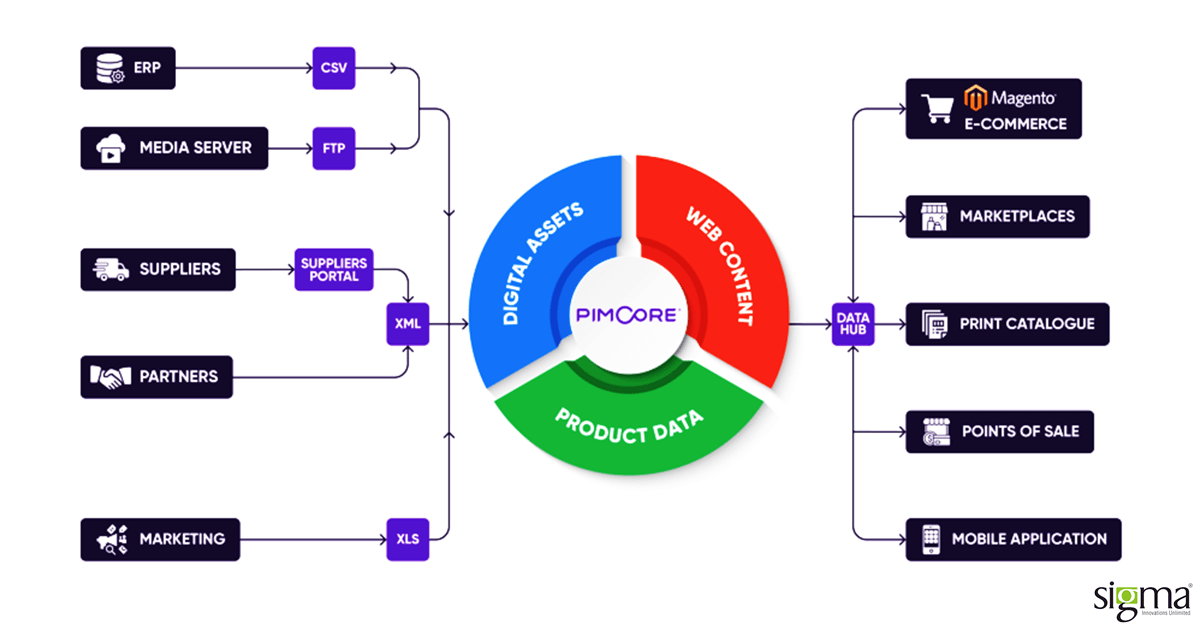Pimcore & Adobe Commerce Integration: All You Need to Know!

Is your Adobe Commerce / Magento Open Source store struggling to manage large volumes of product data across multiple SKUs? Or is your workflow cluttered, making it difficult to maintain omnichannel consistency? If that’s the case, integrating your Adobe Commerce / Magento Open Source store with a Product Information Management (PIM) solution is the right choice to streamline your workflow and product data.
What is PIM?
A Product Information Management (PIM) system is designed to centralize, manage, and enrich product data efficiently. It ensures consistency across multiple sales channels, streamlines workflows, and enhances collaboration between teams.
The Need for a PIM Solution
A PIM system allows you to manage all product data in a single repository. With its advanced capabilities for data enrichment, you can ensure superior data quality, enhanced team collaboration, and optimized workflow management, all while supporting your business growth.
Emerging Trends in PIM Solutions
- SaaS-based PIM provides flexibility, access from any device, and supports multiple user profiles.
- Scalable storage that grows with your catalog.
- Real-time synchronization to ensure up-to-date information and automated data distribution across platforms.
- AI-powered automation to improve product categorization and recommendations.
- Omnichannel content delivery to maintain consistency across various sales platforms.
- Channel-based pricing flexibility.
- Headless & composable PIM.
- Personalization enhancement through Product Experience Management (PXM).
Popular PIM Solutions
Several PIM solutions cater to businesses of different sizes and needs. Some of the most popular ones include:
- Pimcore – A powerful open-source PIM that offers advanced data modeling and omnichannel publishing.
- Akeneo – A user-friendly PIM solution with strong data governance capabilities.
- Informatica PIM – Enterprise-grade PIM with robust automation features.
- Salsify – Focuses on product experience management and syndication.
- Plytix – A cost-effective PIM designed for small and medium businesses.
Why Do You Need a PIM When You Have Adobe Commerce / Magento Open Source?
While Adobe Commerce / Magento Open Source is a highly efficient platform, integrating it with Pimcore’s PIM system can significantly enhance your website’s capabilities. While both platforms offer distinct features, PIM provides a higher level of control over product data, workflow management, and omnichannel commerce.
If your business operates across multiple sales channels—such as offline stores in addition to an Adobe Commerce / Magento Open Source online store—PIM can serve as the master data source for all sales channels, ensuring seamless and accurate catalog updates.

Benefits of Pimcore Adobe Commerce / Magento Open Source Integration
Imagine a centralized data management system that integrates product data, marketing content, team collaboration, and customer experience in a single hub. That’s exactly what Pimcore and Adobe Commerce / Magento Open Source integration offers.
Key Advantages:
- Manage large product catalogs, typically exceeding 15,000 SKUs.
- Automate the removal of inconsistent and obsolete data.
- Ensure seamless integration with multiple marketplaces.
- Optimize workflows and boost employee productivity.
- Improve customer experience through omnichannel consistency.
- Faster Time-to-Market.
- Cost Savings.
- Improved Scalability and Flexibility.
- Enhanced Customer Experience.
In a nutshell, Pimcore and Adobe Commerce / Magento Open Source integration provides a comprehensive, scalable solution that adapts to evolving business needs while improving customer interactions with your brand.
How to Integrate Pimcore with Adobe Commerce / Magento Open Source
Integrating Pimcore with Adobe Commerce / Magento Open Source involves configuring the Pimcore-Magento connector, synchronizing product data, and mapping attributes. Additionally, integration with ERP and third-party systems ensures seamless operations and consistency across channels.
Step-by-Step Process:
- Integration of Pimcore and Enterprise Resource Planning (ERP)
Connect Pimcore with your ERP system to ensure smooth data flow between inventory, orders, and customer information. - Setup Pimcore Adobe Commerce / Magento Open Source Connector
Install and configure the Pimcore-Magento 2 connector to establish a seamless link between the two platforms. - Configuring the Pim Adobe Commerce / Magento Open Source Connector
Adjust settings and establish proper communication between Pimcore and Adobe Commerce / Magento Open Source for smooth synchronization. - Synchronizing the Contents Between Magento and Pimcore
Enable automated data transfer to ensure real-time updates of product data, pricing, and inventory. - Content Mapping Between Pimcore and Magento / Adobe Commerce
Define and map attributes, categories, and relationships between products to maintain consistency across platforms.
- Integration of Pimcore and Enterprise Resource Planning (ERP)
Overcoming Challenges in Pimcore and Adobe Commerce / Magento Open Source Implementation
- Data Mapping & Synchronization – Ensuring smooth data flow between Pimcore and Adobe Commerce / Magento Open Source without inconsistencies.
- Extension Compatibility – Managing conflicts that may arise with existing extensions used in the Adobe Commerce/Magento open-source setup.
- System Performance – Optimizing integration to prevent slowdowns and inefficiencies.
- User Experience – Simplifying navigation and usability for teams managing product data.
- Security – Protecting sensitive business data from potential threats.
- QA & Documentation – Conducting thorough testing and maintaining clear documentation to ensure a seamless integration process.
How Does Pimcore Integration Improve Digital Commerce?
- Data Accuracy – Ensures error-free product information.
- Robust APIs – Facilitates seamless third-party integrations.
- Better Traceability – Tracks changes and updates efficiently.
- Marketplace Integration – Enables smooth syndication across platforms.
- Omnichannel Consistency – Delivers a unified brand experience.
- Product Personalization – Enhances tailored customer experiences.
- Improved Productivity – Streamlines workflows and increases efficiency.
Conclusion
For businesses looking to scale their eCommerce operations, integrating Pimcore with Adobe Commerce / Magento Open Source is a game-changing strategy. With centralized product data management, enhanced automation, and improved accuracy, you can drive efficiency, enhance customer experiences, and future-proof your eCommerce store. If managing large product catalogs and maintaining omnichannel consistency is a challenge, then Pimcore and Adobe Commerce / Magento Open Source integration is the right solution for you.




